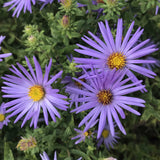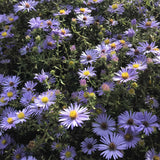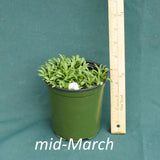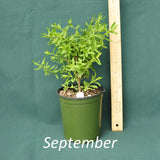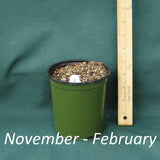Covered with lavender-blue flowers, Raydon’s Favorite Aster steals the show in the fall.
- Excellent source of nectar for migrating monarch butterflies
- Drought tolerant
- Is slightly taller and blooms a week or two later than October Skies Aster
Details
- 3 feet tall and 3 to 5 ft. wide
- Perennial that dies down in the fall and emerges again in the spring
- Hardy in USDA hardiness zones 4, 5, 6, 7, and 8
Flowering period
In central North Carolina, flowering begins in October and lasts around four weeks.
How to grow
Raydon’s Favorite Aster is easy to grow and thrives in well-drained soil. Avoid planting in wet soil and low lying areas. Plants produce more flowers and grow more compactly in full sun.
Care and maintenance
Cut plants down to ground level any time after a hard frost. To prevent older plants from splaying out, cut the stems back by half in June or July for a more compact habit.
Where to plant
It can be planted towards the back of the flower beds with Fireworks Goldenrod to create a memorable fall display.
When to plant
Anytime the ground isn’t frozen.
Spacing
4 to 5 feet apart when planting in groups.
When will my plant flower?
Plants purchased and planted before September will flower their first year.
Native habitat and range
Symphyotrichum oblongifolium is native to dry prairies and rocky slopes in scattered locations throughout the eastern and midwestern United States.
Source and origin
Plants are grown from cuttings here at the nursery. Thanks to Raydon Alexander, this outstanding Aster went from a pass-along plant in south Texas to national award-winning stature when he shared it with Holbrook Nursery. For those of you who are interested in the origins of plants, here is a link to the letter Raydon sent to Allen Bush of Holbrook Nursery with the plant in 1991.
| States | Orders up to $50 | Orders $51 to $100 | Orders over $100 |
| AL, DE, GA, KY, MD, NC, OH, PA, SC, TN, VA, and WV | $16 | $18 | $20 |
| AR, CT, FL, IL, IN, LA, MA, MI, MO, MS, NH, NJ, NY, RI, VT, and WI | $18 | $20 | $22 |
| IA, KS, ME, MN, OK, and TX | $20 | $22 | $24 |
| CO, NE, ND, and SD | $22 | $24 | $26 |
Sorry, we can't ship plants outside of the continental United States or to AK, AZ, CA, HI, ID, NM, NV, OR, UT, and WA due to agriculture restrictions.
When will my order be shipped?All plants are shipped within two weeks of placing an order.
Is it okay to plant in the winter?Yes, as long as the soil is not frozen. Planting native perennials in winter and early spring gives your plants a head start before the summer heat arrives.
What if it’s too cold to plant where I live, but I want to buy a plant before it sells out?Dormant plants can safely be kept in a basement, garage, or cool room until you are ready to plant in late winter or early spring.
How will my plants get delivered?Most orders are shipped on Monday or Tuesday via UPS Ground, which depending on the destination takes between 1 to 4 days.
Are your plants shipped in their containers?Yes, all our plants are shipped in their growing containers. The majority are grown in containers that are 4.5 inches wide by 5 inches deep and 32 fl. oz. / 946 ml in volume.
Do you guarantee your plants?We guarantee our plants to be healthy, ready for planting and correctly named. We are not able to guarantee whether a plant will grow in your garden as there are too many circumstances that are beyond our control.
On rare occasions, a plant shipped dormant may fail to emerge from its dormancy. If this happens, please let us know. If you are concerned about a plant, please contact us within 14 days to let us know. If we can’t help you make it grow, we’ll send you a new plant or issue a refund.
You can return your plants if you no longer want them once they arrive. To receive a refund (minus 20% restocking fee) the plants must be returned in good condition. Return shipping is the customer’s responsibility.
Can I cancel my order?Yes, you can cancel your order. Please visit our terms and service page for details.
What about sales tax?We propagate our own plants and are not required to collect North Carolina sales tax.
Where can I find information about your plants?Here are some FAQ on how we grow plants.






